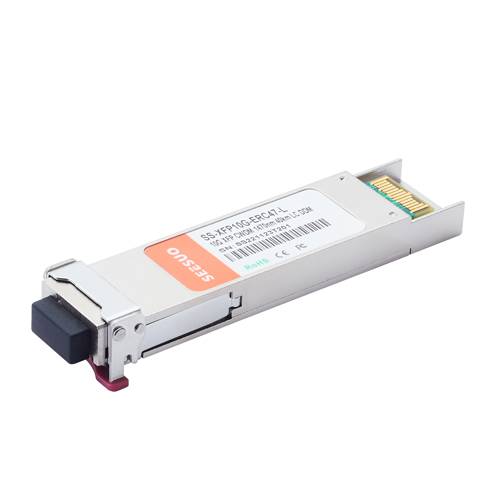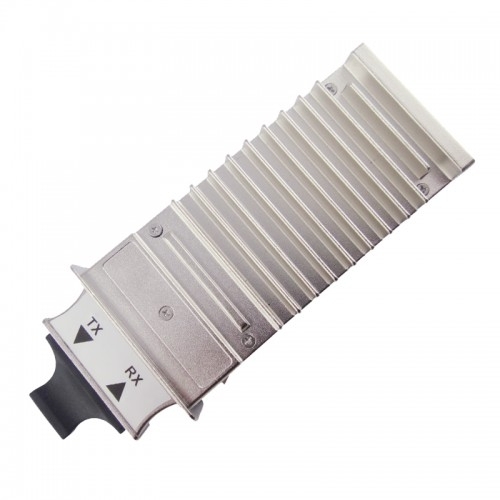- Related articles
- Market Trends for Optical Interconnection Hardware in 2023
- Optical Transceivers for Cisco SG550XG-24T-K9-UK Switch
- What is a DWDM transceiver?
- All Cisco MA-SFP-10GB-LRM's information (List price, Specs, Datasheet PDF, Compatibility m
- Optical Transceivers for Cisco WS-C2960XR24TDI-RF Switch
- Ways to Use PCMCIA Network Card Slot?
- Cisco OneX Converter Module: the CVR-X2-SFP10G & CVR-X2-SFP10G=
- What is GPON and EPON
- Optical Transceivers for Cisco SF200E-48-UK Switch
- Optical Transceivers for Cisco WS-C3560CX-8TC-S Switch

Definition:
XFP modules are hot-swappable and protocol-independent. They typically operate at near-infrared wavelengths (colors) of 850 nm, 1310 nm or 1550 nm. Principal applications include 10 Gigabit Ethernet, 10 Gbit/s Fibre Channel, synchronous optical networking (SONET) at OC-192 rates, synchronous optical networking STM-64, 10 Gbit/s Optical Transport Network (OTN) OTU-2, and parallel optics links. They can operate over a single wavelength or use dense wavelength-division multiplexing techniques. They include digital diagnostics that provide management that were added to the SFF-8472 standard. XFP modules use an LC fiber connector type to achieve higher density.
The 10-Gigabit Ethernet X2 transceiver module is a hot-swappable I/O device that plugs into 10-Gigabit Ethernet ports. Figure 1 shows an X2 transceiver module with the major features identified. The X2 transceiver module connects the electrical circuitry of the system with the optical or copper network.
Difference between X2 and XFP
X2 10G
- Compatible with SENPAK MSA Rev 3.0
- Support of IEEE 802.3ae 10GBASE-L
- XENPAK MSA package with duplex LC connector
- With Digital Diagnostic Monitor Interface
- Operating temperature range 0 to 70 degrees Celsius
- Hot Pluggable 70-PIN Connector with XAUI Electrical Interface
XFP 10G
- 850nm/1310nm/1550nm laser diode transmitter
- Support 9.95Gb/s to 11.3Gb/s data rate
- Below 2.5W power consumption
- XFP MSA package with duplex LC connector
- With digital diagnostic monitor interface
- Operating temperature range 0 to 70 degrees Celsius.
- No referance clock requirment
Difference between SFP and X2:
SFP transceivers are expected to perform at data speeds of up to five gigabits per second (5 Gbps), and possibly higher. Because SFP modules can be easily interchanged, electro-optical or fiber optic networks can be upgraded and maintained more conveniently than has been the case with traditional soldered-in modules. Rather than replacing an entire circuit board containing several soldered-in modules, a single module can be removed and replaced for repair or upgrading. This can result in a substantial cost savings, both in maintenance and in upgrading efforts.
X2 optics is essentially an enhanced version of the Xenpak. It also has the same connector as a Xenpak (SC). Cisco introduced the X2 form factor and HP is producing them as well. Although X2 optics is quite old and bulky, they are still used in the newer product line of Cisco, i.e. the ASR 9000 series. The reason for this is that Cisco has not officially offered the SFP+ for longer distances or a SFP+ for DWDM. The X2 optics come in 4 different versions: SX, LX, EX and ZX. The SX version will work on Multi Mode fiber, the LX, EX and ZX work only on Single Mode fiber.
Conclusion:
XFP has appeared before the SFP+. It is also a standardized form factor for serial 10 Gb/s fiber optic transceivers. It is protocol-independent and fully compliant to the following standards: 10G Ethernet, 10G Fibre Channel, SONET OC-192, SDH STM-64 and OTN G.709, supporting bit rate from 9.95G through 11.3G. XFP transceivers are used in datacom and telecom optical links and offer a smaller footprint and lower power consumption than other 10 Gb/s transponders. The electrical interface to the host board is a standardized serial 10 Gb/s interface called XFI.
X2 optics always shaves a Tx (sending laser) and a Rx side (receiver). The difference between the sending power (in dB) and the receiving power (in dB) is called the power budget and will determine the distance an optic can cover, where the laser light (in nanometers) also has an important role.























































